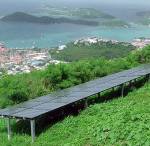Tourists in their thousands flock to the U.S. Virgin islands for the beautiful beaches, warm Caribbean waters, and plentiful sunshine. But another fact about the “USVI”, as they are known, is they are also one of the heaviest consumers of oil per capita in the world.
Like many islands, the USVI is almost 100 percent dependent on imported oil for electricity. Residents pay about 47 cents per kilowatt hour to light their homes and run their appliances – up to five times what Americans pay on the mainland. Natural rainfall is so scarce on the USVI that sea water is processed into drinking water in oil-powered desalination plants.
But a renewable energy revolution is under way that could radically transform the USVI power grid, with Governor John P. de Jongh Jr., working with the U.S. Department of Energy’s National Renewable Energy Laboratory (NREL) setting a goal of reducing use of fossil fuels by 60 percent in the next 15 years.
In 2010, the Islands burned 2.5 million barrels of oil for energy. The environmental risks associated with shipping this toxic material to a pristine coastline – and also importantly, the costs – have become increasingly untenable, so the NREL and USVI government have decided on a raft of renewable energy and efficiency measures aimed at cutting dependence on imported oil.
The NREL hopes to use the process as a blueprint on how to achieve the same reductions on the mainland.
Most renewable technologies will be utilised in the plan. Rooftop solar power systems and solar hot water can save over 60,000 barrels of oil each year. A half-megawatt solar PV farm is planned for the island of St Thomas, and will save 100,000 barrels of oil each year.
The plan is to deploy 22.5 megawatts of wind power capacity through a mix of small and utility-scale wind turbines, which would deliver electricity to Island residents for 10 cents per kilowatt hour, vs. the 47 cents currently paid now.
Achieving energy efficiency will be the major factor in the Virgin Islands efforts to become oil-free. Over half of planned 60% energy savings (38%) come from energy efficiency measures, with biomass (2%), landfill gas (3%), solar power (3%), wind energy (6%), and waste-to-energy (8%), making up the rest of the USVI’s renewable revolution.












































